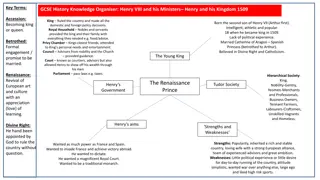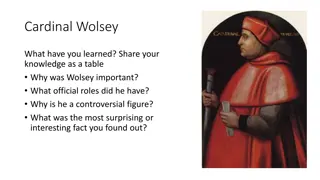Henry Clay's
President Madison's American System aimed to unite the different regions of the United States and create a self-sufficient country with a stable economy. This plan included developing transportation systems, establishing protective tariffs, and resurrecting the national bank.
Download Presentation

Please find below an Image/Link to download the presentation.
The content on the website is provided AS IS for your information and personal use only. It may not be sold, licensed, or shared on other websites without obtaining consent from the author.If you encounter any issues during the download, it is possible that the publisher has removed the file from their server.
You are allowed to download the files provided on this website for personal or commercial use, subject to the condition that they are used lawfully. All files are the property of their respective owners.
The content on the website is provided AS IS for your information and personal use only. It may not be sold, licensed, or shared on other websites without obtaining consent from the author.
E N D
Presentation Transcript
American System: Introduction In 1815, President James Madison presented a plan to congress that would help unite the different regions of the United States. President Madison wanted to create a self-sufficient country that would maintain a stable economy, and develop a united country. Three major points of the American System: 1. Developing transportation systems 2. Establishing a protective tariff 3. Resurrecting the national bank
American System: Definition What is Henry Clay s American System? House Speaker, Henry Clay coined the term American System in 1815, after President Madison created a plan to unite the Northern and Southern economies. The President s plan to unite the nation was welcomed by the senate and the house, and quickly a plan was set in place to employ this new American System.
Think about it Task: Imagine you are currently the President of the US, and you have to create a plan for economic reform. How would your American System help the US become independent of other nations? Make sure that you are creating a system that is fair and beneficial to all regions of the US, and explain how your reform plan helps the US economy. 1.
North Economy: +/- Northern Economy: Strengths 1. The north had just experienced an Industrial Revolution, and was producing manufactured goods. 2. New methods of transportation that brought goods to and from the manufacturing north. 3. A new, national currency that enabled the north to trade with the south and west. Northern Economy: Weaknesses 1. Poor soil, low crop production, few livestock.
Southern/Western Economy: +/- Southern/Western Economy: Strengths 1. Good and rich soil for plantation farming. 2. Increased slavery, increased productivity. 3. Use of the Mississippi River for transportation of goods between the north and south economies. Southern/Western Economy: Weaknesses 1. No factories for manufacturing goods. 2. Heavy, intense labor needed to run the plantations smoothly in the south.
Venn Diagram: North v. South Task: Compare and contrast the northern and southern economies using a Venn diagram. Use a (+) symbol for a positive comparison, and use a ( ) symbol for a negative comparison. You should include at least three differences and three similarities between the two economies. Make a concluding statement about the similarities and differences of the two economies. Share the conclusion with the class or small group.
Transportation Developments 1807- Robert Fulton s Clermont makes its maiden voyage, 150 miles from New York City to Albany. 1811- Construction of the National Road begins between Cumberland, MD and Vandalia, Il. 1825- Erie Canal opens a 363-mile waterway that connects the Hudson River to Lake Erie. 1825- First steam locomotive was used to transport goods across different regions of the country. 1838- National Road opens to the public, tolls are required to help offset construction costs.
Protective Tariffs: Tariff of 1816 1816- President James Madison proposes a tariff that would tax all imported foreign goods. 1. The proposed tariff would help the American manufacturing economy become more competitive with the foreign markets, because the imposed tariff would offset the prices of foreign/domestic goods. 2. The north encouraged the tariff because it would improve the their economy and increase total profits. 3. The south and west discouraged the tariff because they would have to pay more for the same products.
National Bank: Part II 1816- The Second Bank of the United States (BUS) was approved for a 20-year term by the Congress. The bank charter would establish a national, guaranteed currency, that would improve national and regional trading of goods and services. 2. The national bank idea had been revived from the presidency of George Washington, and had become vastly popular among all regions of the country. 1816- James Monroe (VA) is elected US President. Begins a new presidency, Era of Good Feelings! 1. 1.























